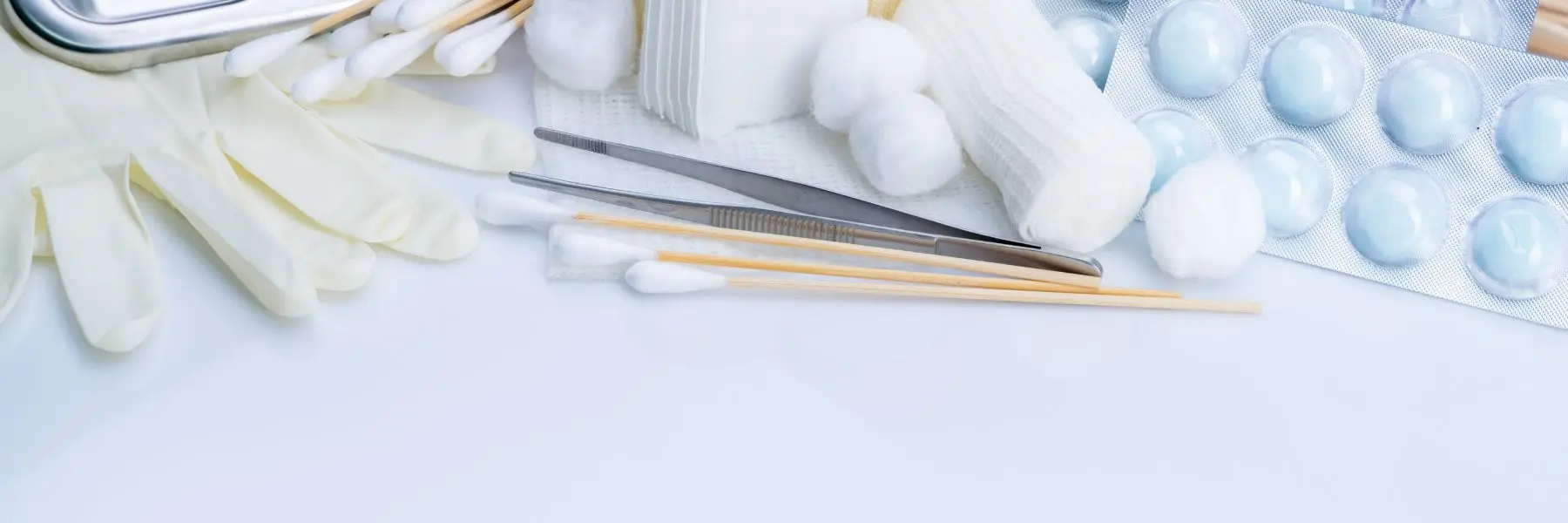Wound Debridement
Wound Debridement
At Collective Care, our wound care professionals provide professional wound debridement services as a fundamental component of comprehensive wound management, involving the systematic removal of damaged, infected, or dead tissue from wounds to promote optimal healing conditions. Our medical procedures play a crucial role in preventing complications and accelerating your natural healing process by creating an environment where healthy tissue can regenerate effectively under the guidance of our experienced healthcare providers.
Schedule your comprehensive wound evaluation today and take the first step toward recovery.
What is Wound Debridement?
Wound debridement is a medical procedure that involves the systematic removal of dead, damaged, or infected tissue from wounds to promote proper healing. This process eliminates necrotic tissue, foreign debris, and bacterial biofilms that can prevent wounds from closing naturally and increase the risk of infection. Healthcare providers use various techniques including surgical removal with instruments, mechanical methods like irrigation, enzymatic treatments that break down dead tissue, or the body’s natural cleaning processes through moisture-retentive dressings.

The procedure is essential for treating chronic wounds, infected injuries, burns, diabetic ulcers, and pressure sores that have accumulated dead tissue or debris. By creating a clean wound environment with healthy tissue exposed, debridement stimulates the body’s natural healing processes, reduces bacterial load, and allows for better penetration of medications. While the specific method chosen depends on the wound type and patient condition, all forms of wound debridement aim to remove barriers to healing and create optimal conditions for tissue regeneration and wound closure.
Our Wound Debridement Services
At Collective Care, we provide comprehensive wound debridement treatments to remove dead tissue, debris, and infection barriers that prevent proper healing. Our healthcare providers use evidence-based techniques to create optimal wound environments for faster recovery.
Our Wound Debridement Options
- Surgical Debridement: Precise removal of necrotic tissue using sterile instruments like scalpels and scissors for immediate results in severe cases.
- Mechanical Debridement: Physical cleaning methods including irrigation and wet-to-dry dressings to eliminate debris and damaged tissue from wound surfaces.
- Enzymatic Debridement: Topical enzyme applications that selectively break down dead tissue proteins while preserving healthy surrounding areas.
- Autolytic Debridement: Moisture-retentive dressing techniques that support your body’s natural healing processes to gradually remove necrotic material.
- Chronic Wound Management: Specialized care for non-healing wounds including diabetic ulcers, pressure injuries, and venous stasis ulcers requiring ongoing debridement.
- Infection Control: Aggressive tissue removal and antimicrobial treatments to eliminate bacterial biofilms and prevent wound complications.
- Pain Management: Comprehensive comfort strategies including topical anesthetics and systemic medications during wound debridement procedures.
- Post-Debridement Care: Complete wound monitoring, appropriate dressing selection, and follow-up assessments to ensure optimal healing progression.
- Advanced Wound Assessment: Thorough evaluation including wound measurement, tissue viability assessment, and healing progress documentation.
- Patient Education: Detailed instructions on wound care techniques, warning signs, and home management strategies following debridement treatments.
Our wound debridement services combine clinical knowledge with compassionate care to help you achieve the best possible healing outcomes. Contact Collective Care today to learn how our wound care specialists can support your recovery journey.
The 4 Types of Wound Debridement
Healthcare providers use four primary wound debridement methods to remove dead tissue and promote healing. Each technique offers unique advantages depending on your wound condition and individual healing requirements.
Primary Wound Debridement Methods
- Surgical Debridement: Sharp removal of necrotic tissue using sterile scalpels, scissors, and forceps for immediate results in severe wound conditions. This method provides the fastest tissue removal and precise control over the debridement process.
- Mechanical Debridement: Physical cleaning techniques including wet-to-dry dressings, irrigation, and hydrotherapy to eliminate dead tissue and debris. These methods use force or friction to mechanically separate damaged tissue from healthy wound surfaces.
- Enzymatic Debridement: Topical enzyme applications that chemically break down dead tissue proteins while preserving healthy surrounding areas. This selective approach uses collagenase or other enzymes to dissolve necrotic material over several days.
- Autolytic Debridement: Moisture-retentive dressing systems that support your body’s natural enzymes and immune cells to remove dead tissue. This gentlest method harnesses the wound’s own healing mechanisms to gradually clean the tissue bed.
- Combination Approaches: Healthcare providers often combine multiple wound debridement methods to achieve optimal tissue removal and healing outcomes. Sequential use of different techniques maximizes effectiveness while minimizing patient discomfort.
- Method Selection Factors: Your wound type, infection status, pain tolerance, and overall health determine which debridement approach works best. Healthcare providers assess these factors to recommend the most appropriate treatment strategy.
Understanding these wound debridement options helps you make informed decisions about your wound care treatment. Your healthcare provider will evaluate your specific situation to recommend the most effective debridement method for optimal healing results.
When You Need Wound Debridement Services
Wound debridement becomes necessary when dead tissue, infection, or debris prevents your wound from healing naturally. Recognizing these conditions early ensures prompt treatment and better healing outcomes.
Conditions Requiring Wound Debridement
- Chronic Non-Healing Wounds: Wounds that remain open for more than four weeks despite appropriate care may need debridement to remove healing barriers.
- Necrotic Tissue Presence: Black, brown, or yellow dead tissue in wound beds requires removal to expose healthy tissue underneath for proper healing.
- Infected Wounds: Signs of infection including increased pain, redness, swelling, or purulent drainage often necessitate aggressive wound debridement.
- Diabetic Foot Ulcers: Thick calluses and dead tissue around diabetic wounds prevent closure and increase infection risk requiring professional removal.
- Pressure Injuries: Deep pressure sores with damaged tissue layers need debridement to eliminate necrotic material and promote healthy granulation.
- Post-Surgical Complications: Surgical sites developing tissue death, dehiscence, or infection may require wound debridement to restore healing conditions.
- Burns with Dead Tissue: Thermal injuries involving necrotic skin and deeper tissues need removal to prevent infection and scarring complications.
- Biofilm Formation: Persistent bacterial films coating wound surfaces resist standard treatments and require mechanical or surgical removal.
- Foreign Debris in Wounds: Contaminated wounds containing dirt, glass, or other materials need thorough cleaning and tissue debridement.
- Venous Stasis Ulcers: Lower leg wounds with fibrinous tissue buildup often require debridement to improve circulation and healing responses.
If you’re experiencing any of these wound conditions, seeking professional wound debridement services can significantly improve your healing trajectory. Early intervention prevents complications and reduces the risk of more extensive treatment needs.
Why Choose Collective Care For Your Wound Debridement Needs
Collective Care provides comprehensive wound debridement services with advanced techniques and compassionate patient-centered care. Our healthcare providers deliver effective treatments tailored to your specific wound healing requirements.
Our Wound Debridement Advantages
- Multiple Debridement Methods: We offer surgical, mechanical, enzymatic, and autolytic wound debridement options to match your specific wound condition and healing needs.
- Advanced Pain Management: Comprehensive comfort protocols including topical anesthetics and systemic medications ensure your wound debridement procedure remains tolerable.
- Sterile Technique Standards: All wound debridement procedures follow strict infection control protocols to prevent complications and promote safe healing environments.
- Personalized Treatment Plans: Individual wound assessments guide customized debridement strategies based on your wound type, health status, and healing goals.
- Experienced Healthcare Providers: Our clinicians possess extensive training in wound care techniques and stay current with latest debridement best practices.
- Comprehensive Wound Assessment: Thorough evaluations including wound measurement, tissue analysis, and healing progress documentation guide effective treatment decisions.
- Post-Debridement Support: Complete follow-up care including dressing changes, wound monitoring, and patient education ensures optimal healing outcomes.
- Advanced Wound Care Technology: State-of-the-art equipment and modern dressing materials enhance debridement effectiveness and patient comfort during treatment.
- Convenient Location Access: Our wound care clinic near me provides easy access to professional debridement services without extensive travel requirements.
- Insurance Coordination: Streamlined billing processes and insurance verification help make wound debridement services accessible and affordable for patients.
Choose Collective Care for wound debridement services that combine clinical excellence with compassionate patient care. Contact us today to schedule your comprehensive wound evaluation and begin your path to optimal healing.
Ready to Start Your Healing Journey?
Don’t let wounds hold you back from living your best life. Our experienced team at Collective Care is ready to provide the professional wound debridement services you need for optimal healing outcomes.
Schedule your comprehensive wound evaluation today and take the first step toward recovery.
Wound Debridement FAQs
How long does the wound debridement procedure typically take? Most wound debridement procedures take between 15 to 45 minutes depending on the wound size, tissue involvement, and debridement method used. Complex cases requiring extensive tissue removal may take longer.
Will I experience pain during wound debridement? Pain levels vary based on the debridement method and individual pain tolerance. Healthcare providers use local anesthetics, topical numbing agents, or pain medications to minimize discomfort during the procedure.
How often will I need wound debridement treatments? Treatment frequency depends on your wound’s healing progress and tissue regeneration rate. Some patients require weekly sessions while others may need debridement every few days or less frequently.
Can wound debridement cause bleeding? Minor bleeding is normal during debridement as healthy tissue is exposed, but excessive bleeding is uncommon. Healthcare providers monitor bleeding carefully and use appropriate techniques to control it.
What should I expect immediately after wound debridement? Your wound may appear larger initially as dead tissue is removed, revealing the true wound size. Some drainage, mild discomfort, and redness around the wound edges are normal responses.
Are there any activities I should avoid after debridement? Avoid soaking the wound in water, strenuous activities that could disrupt healing, and removing dressings without provider guidance. Follow specific activity restrictions based on your wound location and type.
How do I know if my wound is healing properly after debridement? Signs of proper healing include decreased wound size, healthy pink or red tissue growth, reduced drainage, and minimal odor. Contact your provider if you notice increased pain, swelling, or unusual discharge.
Can all wounds benefit from debridement? Not all wounds require debridement. Healthcare providers evaluate each wound individually to determine if tissue removal will benefit the healing process or if other treatments are more appropriate.
